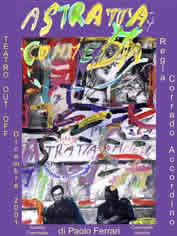 |
Astratta
Commedia
Paolo Ferrari
Directed by Corrado Accordino |
 |
An
outstanding play which has no equal, is going to impose itself on theatre
audience and critics because of its strong innovative impact. Everything is
new in this play, from its content (the human evolution) which is made manifest,
to the characters (beings under constant transformation), from the place in
which the scene evolves(an immense brain), to the many musical compositions
purposely created.
Paolo Ferrari with masterly insight has brought on stage the human being as
a whole with his delusions, his fears and obsessions but also with his subtle
irony, his abandonment and his capacity for happiness, starting from some
crucial scientific thoughts, which have gradually turned into art as well
as into the very essence of life.
Through Astratta Commedia we also mean to experiment a new way of communicating
according to the rules of a new science, which the Author calls "acomplexity
in-Absence": on The edge of chaos and beyond. To this purpose we let
different languages - ranging from drama, arts, theoretical and experimental
science, to philosophy and care, poetry and music - converge and find expression
through a singular multi-layered theatre construction which digs into the
very core of the life-death bond and its transmutation made possible by the
special place to which theatre belongs as a result of its anthropological
and historical disposition. To such a change, so human and yet placed in some
other place full of mystery, the audience is - now gently and now forcefully
- directly invited to take part so as to become, at one and the same time,
beneficiary and originator (a-person) of the play: hence feelings and reason
do suddenly become manifest; thinking and feeling turn out to be true and
natural companions for everybody.
The rules usually involved on the stage to accomplish a play, have changed.
The actor, as well as the audience, acts in an environment so far unknown,
and sails through an overwhelming narration full of sudden changes and unexpected
breakthroughs. It is the exploration of a mental and physical place at the
same time, as terrifying as human beauty. Action takes an incessant rhythm,
and the story easily switches from tragedy to comedy, showing its painful
and bloody aspects and yet even moving and hilarious, in the constant and
vital tension that permeates the whole play.
The characters are not unchanging entities, but real and abstract souls, they
do not wear the mask of predictability, but do rather reflect life and death
at the same time. The construction of the play is in movement and undergoes
constant transformation, while it is the character itself who takes form and
life within the actor, wearing his body and voice, resorting to his emotions,
mind and ideas so as to make the actor other than himself, in an absent space.
It is therefore neither an unreal nor a surreal imagination tending to distort
and misinterpret the world, it is rather an unmerciful representation, the
fall of man towards the conquest of reality.
Many people have contributed to bringing this play on the stage: from the
Centro Studi Assenza, founded by Paolo Ferrari, to the Accademia di Belle
Arti di Brera caring for the set design, from the sound engineers and the
technicians for the electronic equipment to the costume designers and the
musicians and, of course, the nine leading actors, heroes of the journey.
CORRADO ACCORDINO